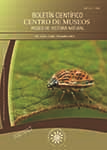Authors
Abstract
The Annonaceae family is characterized by the presence of many bioactive substances from different chemical nature. Alkaloids, flavonoids and acetogenins have been characterized and reported in this family. The bioactivity of this type of Annonaceae plant metabolites is associated with its effect as insecticidal, antitumoral, antibacterial, antimalarial, leishmanicidal, anthelmintical and cytotoxical properties. Since 1982, bioassays have been developed for the determination of cytotoxicity with the use of "Brine Shrimp" (Artemia salina), which is used for toxical screening of high toxicity extracts. This research aims to evaluate the toxic activity of different polarity extracts obtained from Annona cherimolioides stem bark. Column chromatography and preparative layer chromatography were applied for extraction and isolation of the alkaloids present in the Annona cherimolioides stem bark. Extracts, fractions and alkaloidal type purified compounds were tested in vivo on Artemia salina to determine cytotoxic activity. A purified compound was obtained, in which the presence of an aporphine nucleus was obtained according to nuclear magnetic resonance 1-H (NMR 1-H) and spectrophotometry. The crude extract showed higher toxicity on Artemia salina (< 250 ppm), due to the synergism of the alkaloids found in this extract and the pharmacological properties attributed to the aporphine nucleus present in extracts, fractions and purified compounds.
References
CASTRO, L.; ALZATE, M. & GUERRERO, G. E. 2010. Estudio preliminar de la bioactividad de extractos de semillas de Annona cherimolia de la familia Annonaceae. Scientia Et Technica 44: 326-330.
FINNEY, D.L. 1978. Statistical Method in Biological Assay, London and High Wycombe, UK.
FLÓREZ-LONDOÑO, Y. & MARTÍNEZ-MUÑOZ, E. 2010. Obtención y evaluación de extractos bioactivos presentes en semillas de Annona muricata de la región cafetera. Tesis de Grado. pp. 87
LEBOEUF, M.; CAVE, A.; BHAUMIK, P.K.; MUKHERJEE, B. & MUKHERJEE, R. 1982. The phytochemistry of Annonaceae. Phytochemistry, 21 (12): 2783–2813.
LEWAN, L.; ANDERSSON, M. & MORALES-GÓMEZ, P.1992. The use of Artemia salina in toxicity. Testing Alternatives Lab. Anim., 20: 297-301.
LOCK, O. 1994. Investigación Fitoquímica. En: Métodos en el Estudio de Productos Naturales. Fondo Editorial PUCP, Lima, Perú.
Mc LAUGHLIN, J.; COLMAN-SAIZARBITORIA, T. & ANDERSON, J. 1995. Tres bioensayos simples para químicos de productos naturales. Rev. Soc. Ven. Quim., 18: 13-21.
MEYER, B.M.; FERRIGNI, N.R.; PUTMAN, J.E.; JACOBSEN, L.B.; NICHOLS, D.E. & Mc LAUGHLIN, J.L. 1982. Brine shrimp: A convenient general bioassay for active plant constituents. Planta Med., 45 (1): 31- 34.
OCAMPO, D. M. 2009. Seguimiento cromatográfico de algunos principios bioactivos presentes en Annona cherimolioides (Annonaceae). Vector 2: 103–112.
SANABRIA-GALINDO, A.; LOPEZ, S.I. & GUALDRON, R. 1997. Estudio fitoquímico preliminar y letalidad sobre Artemia salina de plantas colombianas. Rev. Col. Cienc. Quim. Farm., 26 (1): 15-19.
SHAMMA, M. 1972. "The isoquinoline alkaloids: Chemistry and Pharmacology", Academic Press, Verlag Chemie, NY, USA.

 PDF (Español)
PDF (Español)
 FLIP
FLIP


















